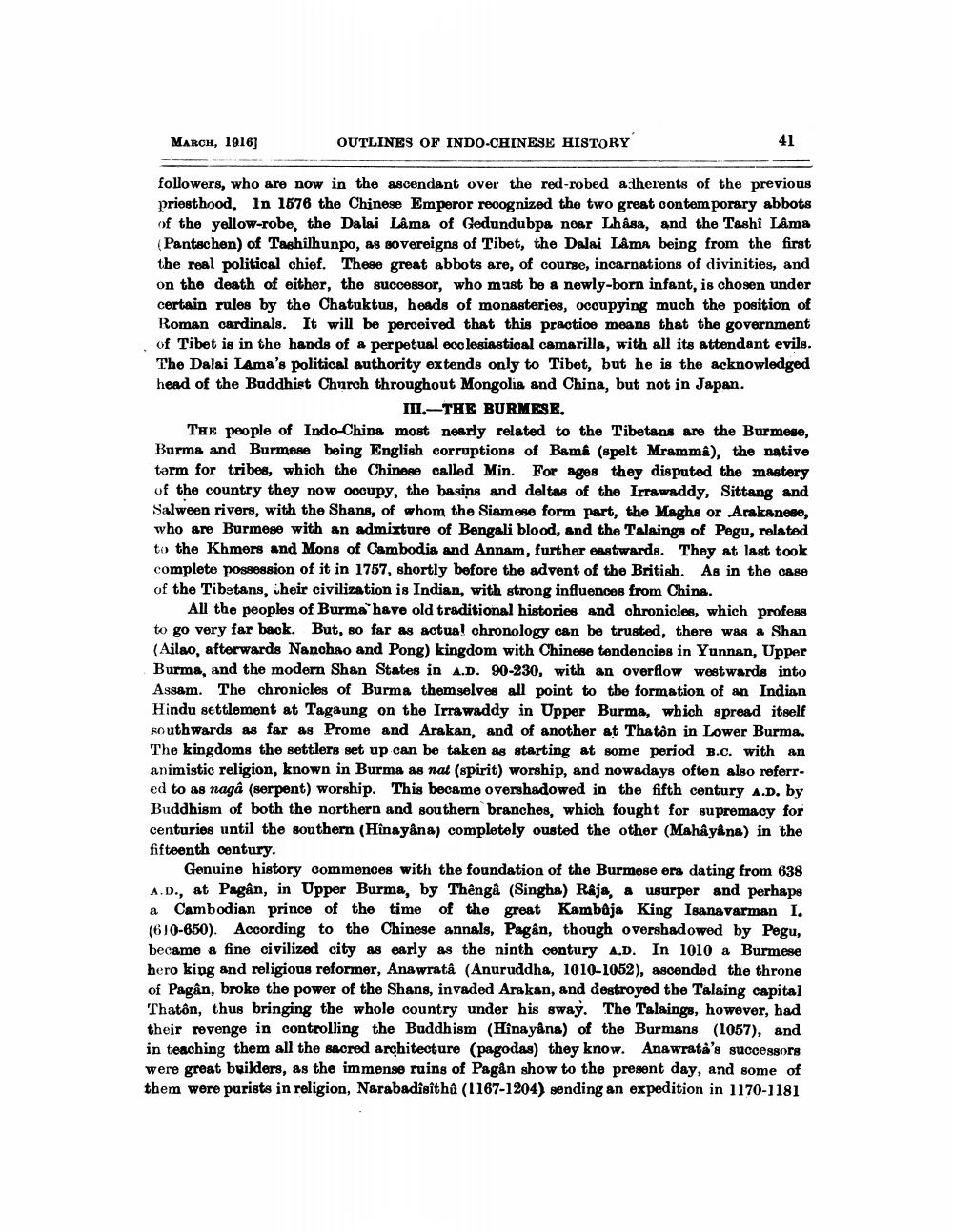________________
MARCH, 1916]
OUTLINES OF INDO-CHINESE HISTORY
41
followers, who are now in the ascendant over the red-robed a herents of the previous priesthood. In 1576 the Chinese Emperor recognized the two great contemporary abbots of the yellow-robe, the Dalai Lama of Gedundubpa noar Lhasa, and the Tashi Lama (Pantachen) of Tashilhunpo, as sovereigns of Tibet, the Dalai Lama being from the first the real political chief. These great abbots are, of course, incarnations of divinities, and on the death of either, the successor, who mast be a newly-born infant, is chosen under certain rules by the Chatuktus, heads of monasteries, occupying much the position of Roman cardinals. It will be perceived that this practice means that the government of Tibet is in the hands of a perpetual ecclesiastioal camarilla, with all its attendant evils. The Dalai Lama's political authority extends only to Tibet, but he is the acknowledged head of the Buddhist Church throughout Mongolia and China, but not in Japan.
III.--THE BURMESE. The people of Indo-China most nearly related to the Tibetans are the Burmese, Burma and Burmese being English corruptions of Bama (spelt Mramma), the native torm for tribes, which the Chinese called Min. For ages they disputed the mastery of the country they now oocupy, the basins and deltas of the Irrawaddy, Sittang and Salween rivers, with the Shans, of whom the Siamese form part, the Maghs or Arakanese, who are Burmese with an admixture of Bengali blood, and the Talaings of Pegu, related to the Khmers and Mons of Cambodia and Annam, further eastwards. They at last took complete possession of it in 1757, shortly before the advent of the British. As in the case of the Tibetans, their civilization is Indian, with strong influences from China.
All the peoples of Burma have old traditional histories and chronicles, which profess to go very far back. But, so far as actual chronology can be trusted, there was a Shan (Ailao, afterwards Nanohao and Pong) kingdom with Chinese tendencies in Yunnan, Upper Burma, and the modern Shan States in A.D. 90-230, with an overflow westwards into Assam. The chronicles of Burma themselves all point to the formation of an Indian Hindu settlement at Tagaung on the Irrawaddy in Upper Burma, which spread itself southwards as far as Prome and Arakan, and of another at Thatôn in Lower Burma. The kingdoms the settlers set up can be taken as starting at some period B.c. with an animistic religion, known in Burma as nat (spirit) worship, and nowadays often also referr. ed to as naga (serpent) worship. This became overshadowed in the fifth century A.D. by Buddhism of both the northern and southern branches, which fought for supremacy for centuries until the southern (Hinayana) completely ousted the other (Mahayana) in the fifteenth century.
Genuine history commences with the foundation of the Burmese era dating from 638 A.D., at Pagân, in Upper Burma, by Thêngå (Singha) Raja, a usurper and perhaps a Cambodian prince of the time of the great Kamboja King Isanavarman I. (610-650). According to the Chinese annals, Pagân, though overshadowed by Pegu, became a fine civilized city as early as the ninth century A.D. In 1010 a Burmese hero king and religious reformer, Anawratâ (Anuruddha, 1010-1052), ascended the throne of Pagân, broke the power of the Shans, invaded Arakan, and destroyed the Talaing capital Thatôn, thus bringing the whole country under his sway. The Talaings, however, had their revenge in controlling the Buddhism (Hinayana) of the Burmans (1057), and in teaching them all the sacred architecture (pagodas) they know. Anawrata's successors were great builders, as the immense ruins of Pagan show to the present day, and some of them were purists in religion, Narabadîsîtha (1167-1204) sending an expedition in 1170-1181




